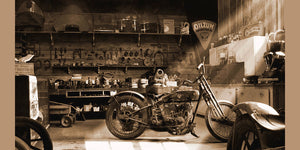Top MX Gear NZ: Prepare for Your Following Off-Road Experience
Top MX Gear NZ: Prepare for Your Following Off-Road Experience
Blog Article
Understanding the Important Parts of a Bike: A Comprehensive Guide for Enthusiasts
For motorcycle lovers looking to boost their riding experience and ensure their bikes run efficiently, recognizing the necessary parts of a motorcycle is extremely important. Each aspect, from the engine's intricate workings to the crucial role of the stopping mechanisms, not only impacts performance however likewise safety and security and convenience.
Engine Parts

The camshaft plays an important duty in controlling the timing of the engine's shutoffs, ensuring the specific opening and closing needed for efficient fuel and air consumption, in addition to exhaust expulsion. This timing is vital to preserving optimum engine performance and efficiency. In addition, the carburetor or fuel shot system, depending upon the bike model, is in charge of blending air with fuel in the correct proportion for burning.
The cooling system, either air or liquid-based, works to preserve the engine's temperature level within operational restrictions, protecting against getting too hot and ensuring longevity - mx gear nz. Each element, meticulously developed and incorporated, adds to the seamless procedure of the engine, specifying the motorcycle's power output and general efficiency
Transmission System
Essential to the motorcycle's performance, the transmission system makes certain effective power transfer from the engine to the wheels. This system consists of numerous critical parts, including the clutch, gearbox, and last drive, each playing an important function in translating the engine's power right into movement. The clutch, normally run by a hand lever, offers to engage and disengage the engine from the transmission, permitting smooth equipment modifications and controlled velocity.
The gearbox, typically referred to as the transmission proper, contains a collection of equipments that cyclists can manually shift with to readjust the bike's rate and torque outcome. These equipments are set up in a series that allows the bike to increase efficiently and preserve optimum engine efficiency across different speeds. Most motorbikes use a consecutive gearbox, needing the motorcyclist to move gears in a predetermined order.
Braking Mechanisms
While understanding the transmission system is essential to harnessing a motorbike's power, just as important is the capacity to manage and quit that power successfully, which is where braking mechanisms enter play. Brakes are important for security and performance, giving the motorcyclist with the required control to navigate numerous terrains and conditions. Usually, motorbikes include 2 sorts of braking systems: disc brakes and drum brakes.
Disc brakes are much more common in modern-day motorcycles due to their superior efficiency. This system provides far better warm dissipation, consistent efficiency, and boosted stopping power, specifically in wet conditions.
Conversely, drum brakes, though less common, are still found in some bikes. They function by pushing brake footwear versus the inner surface of a drum affixed to the wheel. While normally less reliable in heat dissipation and stopping power, drum brakes are less complex and more cost-effective.
Recognizing these stopping systems' subtleties enables motorcyclists to preserve their bikes effectively and value the design that ensures reliable and secure stopping.
Suspension and Guiding
Suspension and steering systems are crucial parts open face motorcycle helmet with visor that dramatically influence a motorbike's handling and trip convenience. The shock absorber, containing forks at my blog the front and shock absorbers at the back, soaks up road abnormalities, enhancing stability and control. Front forks, upside down or normally telescopic, compress and rebound to alleviate influences, while back shock absorbers preserve tire contact with the road, crucial for traction and safety.
Guiding, focused around the handlebars, connects the rider to the motorcycle's directional control. The steering head bearings make sure smooth procedure, permitting accurate maneuverability. Appropriate positioning and maintenance of these bearings are crucial for predictable steering reaction and reducing rider tiredness.
The suspension's adjustability is an additional vital element; preload, damping, and rebound settings permit modification to suit different riding styles and problems. This flexibility is important for enhancing efficiency, whether browsing metropolitan roads or tackling rugged tracks. Advancements like electronic suspension systems use real-time modifications, enhancing ride high quality across diverse terrains.

Electric Systems
After ensuring a regulated and smooth trip with effective suspension and guiding systems, attention turns to the electric systems, an essential element of modern-day motorbikes. These systems play a critical duty not only in beginning the engine but also in powering numerous elements that boost the performance and security of the motorcycle.
At the heart of a motorbike's electrical system is the battery, which stores electrical power required for beginning the engine informative post and powering auxiliary systems - mx parts nz. The generator or generator, paired with the rectifier-regulator, ensures the battery remains charged while the motorbike functions, transforming power into electric power and maintaining voltage levels
The ignition system, an additional critical element, is accountable for igniting the air-fuel mix in the engine's cylinders. Modern motorbikes commonly use an electronic ignition system, offering better performance and dependability compared to conventional systems.
Lights systems, including fronts lights, tail lights, and indications, are likewise essential, guaranteeing exposure and safety for the motorcyclist. Added digital parts such as sensors, control units, and presents add to sophisticated attributes like fuel injection management, anti-lock braking systems (ABDOMINAL MUSCLE), and electronic dashboards, further enhancing the riding experience.
Verdict
A detailed understanding of a motorcycle's necessary parts, including the engine, transmission system, braking mechanisms, suspension, guiding, and electrical systems, is important for fanatics intending to enhance convenience, safety and security, and performance. Proficiency of these elements permits educated choices concerning upkeep and upgrades, ultimately boosting the riding experience. By integrating this knowledge, cyclists can guarantee their bikes run at peak efficiency and dependability, thus maximizing both pleasure and long life of their cars.
For bike fanatics looking to elevate their riding experience and guarantee their bikes run efficiently, understanding the essential components of a motorbike is extremely important.Essential to the bike's functionality, the transmission system makes certain effective power transfer from the engine to the wheels.While comprehending the transmission system is vital to harnessing a motorcycle's power, equally essential is the capacity to manage and quit that power successfully, which is where stopping mechanisms come into play. Usually, motorbikes include 2 kinds of braking systems: disc brakes and drum brakes.
A comprehensive understanding of a motorbike's crucial elements, including the engine, transmission system, braking systems, suspension, guiding, and electric systems, is essential for enthusiasts intending to optimize comfort, efficiency, and safety.
Report this page